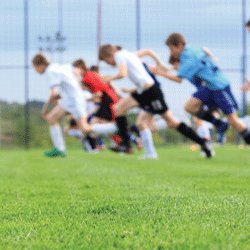Strength and conditioning for the undersized team sports player is one of the most common requests that our NK Fitness S&C coaches receive. Young athletes grow and mature at different rates, both biologically and emotionally. Late developers are often at disadvantage in many team sports that may include elements of physical contact, such as football, rugby and hockey. Therefore, early maturing children are at a distinct advantage. This concept is know as the ‘Relative Age Effect’ and we’ve covered it previous blog posts. The challenge for the undersized player is how to overcome this distinct disadvantage. For some it can be too much and they fall away from the sport. However, if we can keep them going, more often than not we find that they do eventually catch up, and in a lot of cases surpass, their early developing peers. Here we look at ways in which strength and conditioning can support the undersized player.
Using the body effectively during sports
Undersized team sports players often feel ‘out-muscled’ in contact situations. For example, larger or stronger athletes can bump or barge them off of the ball. Therefore, the smaller athlete may shy away from contact situations. They may also find themselves at an increased risk of being injured during these contact scenario’s. One of the first things that an S&C coach can do is teach the young athlete how to use their body more effectively. Introduced early on this can have an immediate impact upon performance. Teaching athletes how to set their base of support, drop their centre of gravity and use their hip effectively can often give them the upper hand against larger opponents. For example, we liken it to a rugby scrum where between two evenly matched teams it’s the one who is lowest that will win.
Once athletes are more comfortable with using their body for contact we look at how their size may provide an advantage. Quite often, the small athlete is playing at a higher level because of their speed and agility. Contact scenario’s in sport often slow the play down. Smaller athletes can use their superior agility to play in way that outwits larger players. For example, think of the small but rapid players in the Centre position of netball. These athletes are good at getting separation from opponents and finding space.
Keeping players healthy
When it comes to the actual strength and conditioning for young athletes, everything must be ‘age appropriate’. There is a growing body of evidence to support the use of resistance training for young people. At NK Fitness, our first priority is to select training activities that promote stability and balance throughout the body’s various joints and limbs. After all, great athletes must accrue many hours playing their sport to develop mastery. Keeping athletes healthy and minimising days lost to illness and injury must feature highly in a junior S&C programme. Therefore, training programmes for young athletes must be broad and general in their application. A programme that focusses upon general preparation will lead to improvements in physical attributes that influence performance, such as strength and speed. It is widely considered that age appropriate strength training accentuates the natural improvements that occur with maturation.
If you are the coach or parent of an undersized team sports player then look into some S&C for them. Introducing some very simple movement and strength exercises can go a long way to improving their confidence. In the long run these athletes may put themselves at an advantage. Late physical maturation along with a sound S&C base is a potent combination. For more information on how we can help young athletes please contact us here.
